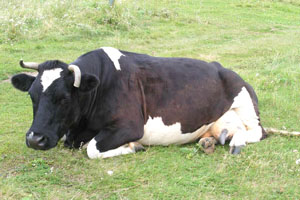Canadian farmers face serious feed shortages
Canadian farmers say they will run out of cattle feed in just a few days due to a severe drought last summer that damaged crops needed to fatten cattle in the winter and transport problems, REUTERS reported.
The drought has devastated prairie pastures and has now forced feedlots in Alberta, the main livestock province, to buy more American corn. However, transporting it north of the border is difficult and expensive.
Canadian Pacific Railway Ltd, the main supplier of corn to Western CANADA, is struggling to keep up with cold weather demand. covid-19 vaccination obligations for cross-border truckers threaten to further disrupt the supply chain.
Feed shortages could reduce the profits of feedlots, farms that raise cattle to slaughter weight, but may not lead to higher retail prices for beef because feedlots have an incentive to sell their cattle to processors as quickly as possible, increasing the supply of MEAT, said Brian Perillat. Senior Analyst at CanFax.
Jacob Buckert, owner of a 20,000-head feedlot near Warner, Alberta, reckons he has five days' worth of feed when he usually has 14 to 30 days' worth of feed. “We don't have any buffer. It's scary,” he said, adding that he was disappointed with the delay in rail transport.
Many feedlot owners make do with donations from neighbors who have enough feed, Buckert said. But finding surplus grain isn't easy - feedlots are filling up more than usual after last fall's drought forced ranchers to sell more cattle to the feedlots, he said.
If slaughterhouses become overcrowded, some feedlots may ration their meager stocks for a longer period of time and delay cattle from reaching slaughter weight, but that adds to costs, says Janice Tranberg, executive DIRECTOR of the Alberta Cattle Fattening Association. She estimates that three-quarters of the province's 1.5 million feedlots face feed shortages.
Canada is the eighth largest exporter of beef and veal in the world. In the United States, the third largest exporter of beef, cattle are geographically dispersed and feed supplies are more readily available. However, US feedlot cattle stocks rose 6% year-over-year in December after pastures dried up due to drought.
US corn shipments to Canada from September 1 to January 13 were 1.085 million tons, nearly six times the five-year average, according to USDA data. About 2.1 million tons have been sold but not shipped yet.
Canadian Agriculture Minister Marie-Claude Bibeau said on Twitter that she had raised the issue of feed shortages with Canadian Pacific on Saturday. CP said in a statement that the company intends to supply feed to the feedlots despite the problems, but did not say if the railroad would take additional steps to address the issue.
Last year, CP moved 8,100 wagons of US corn to Alberta, more than 13 times the previous year's volume, a company executive said last week. Deliveries of dried grain to refineries, another feed product, jumped 300%.
Pig farmers fear their feed problems could also worsen as some U.S. soymeal shipments have already been cancelled, said Cam Dahl, general manager of the Manitoba Pork farming group. He attributed the cancellation to vaccination bans, which led to a reduction in the number of drivers.

